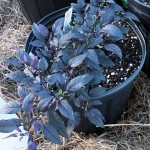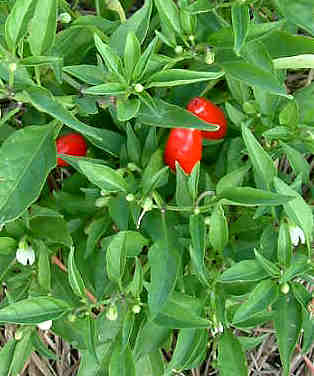Pepper Garden – Fall 2014 Redoux
For my homegrown peppers garden a la Fall 2014, there have already been changes. It’s amazing how fast plans can go out the door and vanish! But, I have new pepper plants in place, so here’s the (new) lineup.
Before I list the peppers, I’ll note that my plans changed because of two things. The first is my greenhouse and the second is the Fall/Winter weather predictions for South Florida. It’s supposed to get rather chilly early on, and a cooler Fall/Winter overall, compared to 2013.
Fall 2014 Pepper Lineup, Take 2
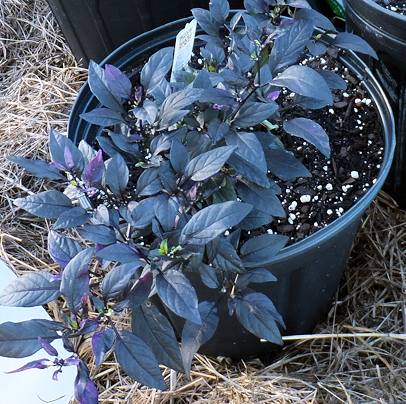
Purple Flash, Early September 2014.
Given the above, my plans changed to buy some starter plants and not grow as many of the seeds (waiting until Thanksgiving to plant those). So here goes for what’s now on deck.
Purple Flash: This is a pepper with purple foliage. The new leaves are green, kind of variegated. As they get older, they turn a lovely dusky purple. Peppers start as purple, then turn red as they mature. Since I bought it as a starter, I picked off all the peppers after I transplanted so as to de-stress the plant. I have it planted in a 5-gallon container.
Cayenne Yellow: A cayenne pepper, only with peppers that mature to a lemon-color, instead of red. It’s supposed to be just as hot as a regular cayenne. I have it cohabiting with a pepper called Cajun Bell in a 12-gallon grow bag / smart pot.
Cajun Belle: This is interesting; it’s a hybrid bell peppers that supposedly is a little on the spicy side. Who could resist — not me, for sure! So I planted it with Cayenne Yellow, as well as an Italian basil plant.
Dragon Cayenne: The name drew me in, so I figured I’d grow it and compare to the Yellow Cayenne plant. It’s sharing a 20-gallon smart pot with a Tabasco pepper and some cinnamon basil.
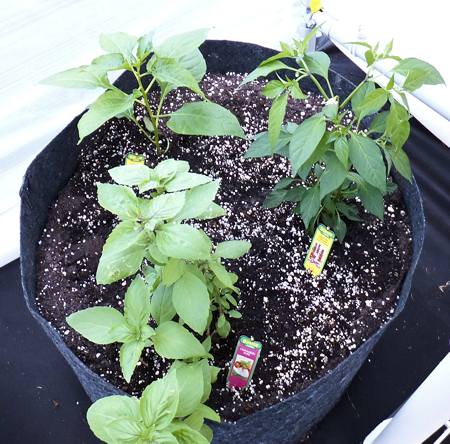
Tabasco (upper left), Dragon Cayenne (upper right) and Cinnamon Basil (foreground). These were just planted 3 days ago.
Tabasco: I don’t recall if this one had a specific variety name, but I picked it to grow for two reasons. First, if I’ve ever grown Tabasco peppers, it’s been years and years, so why not try them? Second, the plant was so pretty! So, in the grow bag with the Dragon Cayenne and basil.
Habanero: No variety listed. I almost didn’t get this starter plant, because habanero peppers typically take a long time to fruit, and it’s already the middle of September. But, I have a greenhouse, so what the heck — live a little! (And hopefully the plant will live more than a little, LOL.) I haven’t decided on where to put this one yet.
Red Bell Pepper: No specific variety name. I didn’t have any regular bells as a starter plant so thought I’d add this one in. It’s also waiting doe its home….which I suspect will be with the habanero. And more basil, or perhaps oregano.
For seedlings that have already popped their heads up, I have:
Fooled You Jalepeno: A no-heat jalapeno pepper, which I have never grown before. It’s a hybrid, and I’ll see how “no heat” it turns out to be. I am growing this mostly for my husband David, who prefers the no-heat.
Trinidad Perfume: This was in my original lineup, and it’s a no-heat habanero. This one is really for me, since I have no idea what a habanero really tastes like — it’s usually all I can do to fan my mouth and look around for ice cream to cool the burn when I eat the regular ones. 😉
Flamingo: A pretty bell pepper that changes colors as the pepper matures. This one is sweet (unlike Cajun Belle). Looking forward to trying it.
Tri-Fetti: This is one of my old (5+ years) seeds. I planted quite a few, not knowing how many would germinate (if any). I see at least one of them coming up, and I think a second one as well. The plants are gorgeous, and I have a hard time finding the seeds, so I am glad that I’ll have some plants and be able to save some new seeds. These are mostly ornamental, but the peppers are edible – and hot!
Orange Thai Hot: These are also from the 5+ year old seed batch, but they aren’t showing any signs of germination yet. Still early days, though, so I’ll wait another couple of weeks to see if I get anything from them.
That’s it for now, but I’ll keep you posted on their progress.
Growing Thai Hot Peppers
Growing Thai Hot Peppers means you’re growing a delight.  The low-growing plant blossoms profusely and produces a bounty of bright red peppers, pointing upwards.
A Little About the Peppers
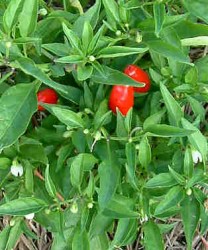 Thai Hot is equally at home in a container or in the ground. A three-gallon container will suit this pretty little pepper just fine. You might even be able to get away with a 1-gallon container, if you keep it well-watered and fertilized.
Thai Hot is equally at home in a container or in the ground. A three-gallon container will suit this pretty little pepper just fine. You might even be able to get away with a 1-gallon container, if you keep it well-watered and fertilized.
I have the plant in the photo (and by the way, you can click on the photo to see a larger picture) growing in the ground, and it’s about 8-inches tall. It’s also spread about 7 inches in diameter.
Now in the photo you only see 3 red peppers, but see all those blossoms and blossom buds? In a couple of weeks, the plant will be covered with peppers.
Can You Eat the Peppers?
Sure you can, but be warned –they aren’t called “Thai Hot” for nothing! One chopped pepper (with seeds) can easily season a large bowl of chili.
Speaking of the peppers, they are only about 3/4″ tall. They aren’t large, but they are potent.
But the charm of these peppers is ornamental. They make a great garden border, looking like bright red flowers. And of course, you could each day pick a few of the peppers in the border and you’d never see a difference.
Growing Thai Hot Peppers
My pepper plant survived some very chilly weather early this season, with temperatures down in the 30’s. It was a little sad-looking until the cold weather passed, but then came back admirably.
As with all chile peppers, they like warm weather and plenty of sunshine. I mentioned that you can grow these in containers easily, and Thai Hot could certainly be grown indoors under lights.
An an FYI, there is a larger variety, called Giant Thai Hot. I haven’t tried it yet, but the peppers get to about 2″ long, instead of the normal 1/2 to 3/4 inches. There’s also a version that has orange peppers instead of red.
Chile Pepper Seeds
It’s been quite cool here in South Florida during January, and now we’re set to get more near-freezing weather this week — it doesn’t bode well for chile peppers! I’ve got one out in the garden already — Thai Hot — but none of my other chile seeds (except for Pretty Purple Pepper) have germinated. My sweet peppers, on the other hand, have pretty much all germinated fine.
Hmm.
The Need for Heat
Thinking that warmth may be the issue (it’s been awfully cool inside the house as well), I decided to spring for a new seed germination heating pad. If you’re not familiar with them, they provide a gentle heat to the bottom of the seed tray. Think of these as heating pads for seeds!
Note: you cannot use a regular “people” heating pad to warm your seeds — they are not designed to operate 24/7 and the seed germination pads are. If you use a regular heating pad, you risk starting a fire (or at the very least developing hot spots and give too much heat to the little seeds).
Now my new one is about 20″ x 10″ in size, and I can put two of my 8″ x 8″ trays on it with room to spare. I generally like only only do smaller trays, in cycles. That way, while one tray is sprouted and enjoying the grow lights, I can be starting another set.
Today’s Chile Pepper Seeds
Some of today’s seeds are new (I just bought them recently) and some are from 10 years ago — treasured seeds that I can’t help but try and grow again.
The new seeds are:Â Cambuci Hot, Jalapeno M, mustard habanero, Peter Pepper and Bhut Jolokia.
The older seeds are: Tam Jalapeno, Jaloro, Hot-Banero and Brazilian Rainbow. The last two especially, since they were both from saved seed in my garden. Hot-Banero was the absolute hottest pepper I have ever grown and Brazilian Rainbow is rare. I’d love to see how my Hot-Banero stacks up against Mustard Habanero and Bhut Jolokia!
Unfortunately, it’s going to be awhile before I really can expect any “action” from my plantings. Chile seeds seem to take quite a bit longer than sweet peppers, so I’m thinking it will be around Valentine’s Day before I see the first of the chiles popping their heads above ground.
Germinating pepper seeds isn’t really hard, except for the waiting part. But given my weather of late, I’d have to wait to plant them even if they were already sprouted and grown enough.
